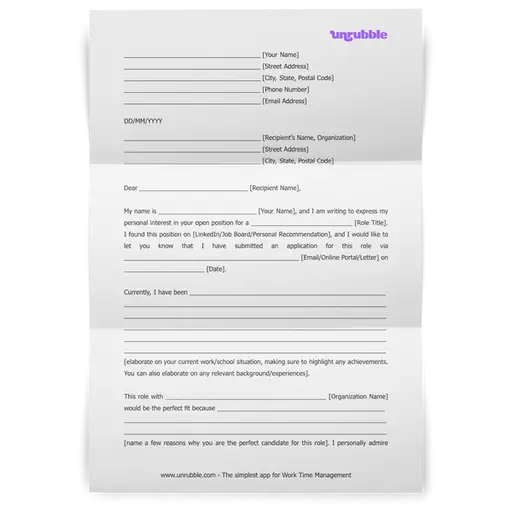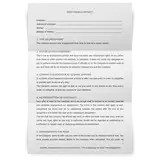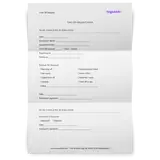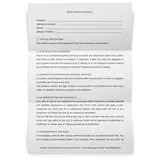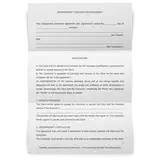If you have an upcoming job interview, downloading a good letter of intent template is a great way to start your application process off on the right foot.
Maybe you’re new to the workforce, or, perhaps it’s been a while since you’ve interviewed – either way, a template can help you feel secure and inspired while drafting your letter to a potential employer.
If you need additional writing help, here is a look at 7 tips to help you get the most out of your letter of intent template.
Here’s a sample Letter of Intent template that can be easily customized and adapted to meet your requirements. It’s free to download and use.
Letter of Intent
Seven Tips for Using Our Letter of Intent Template
1. Research the Organization You Are Applying To
One thing a letter of intent template can’t do for you is to research the organization that you are applying to. However, this is arguably the most important step in the letter-writing process!
Before writing anything, make sure to seek out some general knowledge about the organization that you plan to write to. A few places you can look for information include:
- The organization’s website
- Active social media pages
- Newspapers and media outlets
- Friends/acquaintances who have experience with the organization
Once you have an idea of who the organization is, you will have a better understanding of how you may fit in with them.
2. Keep it Simple
Once you have your sample letter of intent downloaded, you’re ready to write! While it may feel overwhelming, it’s important to remember that it’s okay – and actually better – to keep things simple.
For starters, limit your letter to only one page. Most hiring managers and recruiters are extremely busy, and many just don’t have time to read more than one page. It’s more important to keep your writing simple, straightforward, and to the point. Avoid using long, complicated words, and just be yourself!
3. Customize Each Letter
Just because you are using a loi template doesn’t mean that the written content and substance of your letter should be bland, boring, or cookie-cutter. You should still make sure that each letter is customized to each organization that you send it to.
With each letter, consider asking yourself the following questions:
- Why do you like the organization?
- What do you admire about the organization?
- Are there any current events or headline stories about the organization that has sparked your attention?
Recruiters and hiring managers can easily sense when a letter has been copied and pasted from another application, so it’s important that you let them know specific reasons why you want to work with them.
4. Be Formal and Courteous
Remember, a letter of intent is a formal document that should be taken seriously. When writing your letter of intent word template, double-check that your language is:
- Formal in tone
- Free from typos
- Grammatically correct
- Courteous and respectful of the reader
- Free from inappropriate jokes and humor
Even if a company has a casual vibe on social media, it is still important that you, as a potential candidate, remain professional in all communications. And this is even more so important when trying to make a good first impression.
5. Don’t Write About Yourself Too Much
Plenty of letter of intent sample pdfs include a spot for you to write about yourself. However, it’s important to remember to maintain balance. The majority of the letter should be about what you like about the organization you are applying to and what makes you a good fit for the role.
You should not use the letter as an opportunity to share your life story. Remember, hiring managers have a limited amount of time to spend reading your letter and application, so make it count with a message that is relevant and focused.
6. Use Your Resume for Help
If you are having trouble completely filling out your free letter of intent template, you can always reference your resume for some guidance. This is particularly helpful when trying to make your background and experiences relevant to the position that you are applying for.
Take a hard look at your resume and pull out one or two key accomplishments. You can then build from these examples to craft a narrative about how your experiences and accomplishments make you a good fit for the job and organization.
7. Be Honest
You may have stumbled upon a number of letter of intent samples that you are impressed with. However, the most important thing to remember when crafting your own is to be honest with yourself and with the recipient. Never copy and paste someone else’s letter, and do not exaggerate or make up lies about yourself.
Hiring managers can easily spot if your letter doesn’t match up with your LinkedIn profile or resume, so just be upfront and honest about your qualifications and experiences. Think of this letter as the initial step in a trusting relationship with an organization and the best way to take that initial step is from a place of authenticity.
Myth busting: common misconceptions about letters of intent in HR
Letters of intent (LOIs) are common in HR for various employment and partnership scenarios, but several misconceptions can lead to misunderstandings. Let's address and clarify five common myths related to letters of intent to enhance your understanding of this important HR tool.
Myth 1: letters of intent are legally binding
Clarification: A letter of intent in an HR context is generally non binding, meaning it does not create a binding obligation to finalize employment or partnership terms. It outlines the basic terms and conditions that the parties agree to negotiate in good faith towards a final agreement. However, certain provisions within the LOI, such as those related to confidentiality or initial due diligence, can be legally binding.
Myth 2: a letter of intent is the same as a binding agreement
Clarification: While a letter of intent sets the stage for a future agreement regarding employment or partnership, it is distinct from a binding agreement like an employment contract or definitive agreement. An LOI typically outlines the proposed transaction terms and the intentions of the parties but leaves room for negotiation and due diligence review before a binding agreement is executed.
Myth 3: letters of intent are not necessary
Clarification: An intent letter serves as a valuable tool in the HR process. It helps to clarify the terms of the proposed employment or partnership, set expectations, and outline the steps required to move forward. This document can facilitate smoother negotiations by ensuring both parties are on the same page regarding key terms such as salary, job responsibilities, and the diligence process.
Myth 4: all parts of a letter of intent are non-binding
Clarification: While the overall letter of intent is usually non binding, it often contains specific sections that are legally binding, such as confidentiality clauses, exclusivity agreements, and provisions for due diligence. It is important to understand which parts of the LOI are binding and which are not to avoid any unintended legal obligations like governing law or "purchase price".
Myth 5: a letter of intent guarantees the employment or partnership will proceed
Clarification: A letter of intent does not guarantee that the proposed employment or partnership will be finalized. It indicates the parties' intention to proceed with negotiations in good faith, but various factors such as the due diligence review, ability to obtain financing, and other unforeseen circumstances can influence whether a final agreement is reached.
By understanding these myths and the facts behind them, HR professionals can better navigate the use of letters of intent in employment and partnership negotiations. Always consider consulting with a legal professional to draft or review your LOI, ensuring it accurately reflects your intentions and protects your interests.
